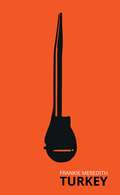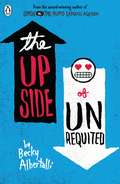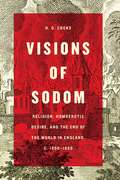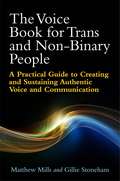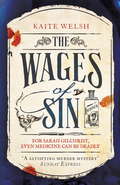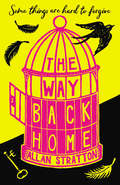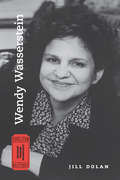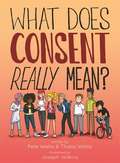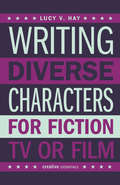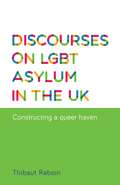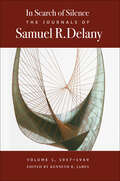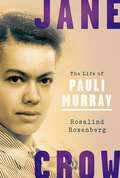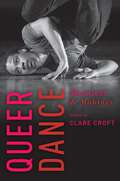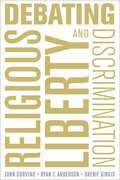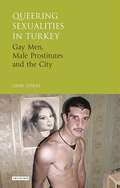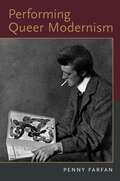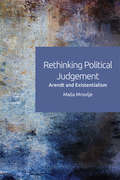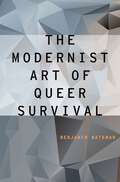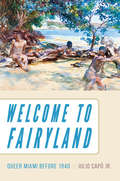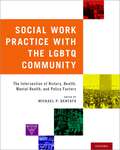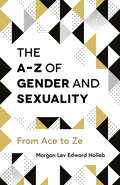- Table View
- List View
Turkey (Oberon Modern Plays)
by Frankie MeredithMadeline wants a baby, so a baby she will have. It doesn't matter that she is in a relationship with a woman, or that they can't afford the high private clinic fees, she'll go about getting this child whichever way she can.Together with her partner, the selfless, kind, stable Toni, the two women explore all the options available to them, but when Madeline gets excited about one possibility in particular, alarm bells are raised for Toni.Now the Nuclear Family is no longer considered the norm, how far can Madeline go to get the baby she so desires? And does it really matter who she has this baby with? People are manipulated, games are played and hearts ultimately shattered in this tale of one woman's longing for a child.
The Upside of Unrequited
by Becky AlbertalliI don't entirely understand how anyone gets a boyfriend. Or a girlfriend. It just seems like the most impossible odds. A perfect alignment of feelings and circumstances . . . Molly Peskin-Suso knows all about unrequited love. No matter how many times her twin sister, Cassie, tells her to woman up, Molly is always careful. Better to be careful than be hurt. But when Cassie gets a new girlfriend who comes with a cute hipster-boy sidekick, everything changes. Will is funny, flirtatious and basically the perfect first boyfriend. There's only one problem: Molly's coworker, Reid, the awkward Tolkien superfan she could never fall for . . . right?A heartwarming and hilarious story about growing up and learning to be comfortable in your own skin. Praise for Becky Albertalli:'The love child of John Green and Rainbow Rowell' Teen Vogue 'I love you, Simon. I love you! And I love this fresh, funny, live-out-loud book.' Jennifer Niven, New York Times bestselling author of All the Bright Places'A remarkable gift of a novel.' Andrew Smith, author of Grasshopper Jungle'Both hilarious and heartbreaking . . . Readers will fall madly in love with Simon' Publishers Weekly (starred review)'A brilliant beacon of optimism and cuteness for LGBTQA+ youth in a genre often bogged down with tragedy and heartbreak. Books like SIMON do change people's lives' Waterstones Darlington Bookseller'A wonderfully charismatic story about coming-of-age and coming out'. Bookseller'Funny, moving and emotionally wise' Kirkus Reviews (starred)'It made me laugh, cry and all the fifty shades of emotions I can think of right now. There is literally no adjectives that would be suffice to describe how brilliant this book is' Goodreads (5 star review)'I think I just felt my heart explode in my chest' Goodreads (5 star review)'One of the most electric, authentic characters I've ever read. . . I LOVE this book. LOVE it. Five freaking stars.' Goodreads (5 Stars)Becky Albertalli is the author of the acclaimed novels Simon Vs the Homo Sapiens Agenda and The Upside of Unrequited. She is a clinical psychologist who specializes in working with children and teens. Becky now lives with her family in Atlanta, where she spends her days writing fiction for young adults.
Visions of Sodom: Religion, Homoerotic Desire, and the End of the World in England, c. 1550-1850
by H. G. CocksThe book of Genesis records the fiery fate of Sodom and Gomorrah—a storm of fire and brimstone was sent from heaven and, for the wickedness of the people, God destroyed the cities “and all the plains, and all the inhabitants of the cities, and that which grew upon the ground.” According to many Protestant theologians and commentators, one of the Sodomites’ many crimes was homoerotic excess. In Visions of Sodom, H. G. Cocks examines the many different ways in which the story of Sodom’s destruction provided a template for understanding homoerotic desire and behaviour in Britain between the Reformation and the nineteenth century. Sodom was not only a marker of sexual sins, but also the epitome of false—usually Catholic—religion, an exemplar of the iniquitous city, a foreshadowing of the world’s fiery end, an epitome of divine and earthly punishment, and an actual place that could be searched for and discovered. Visions of Sodom investigates each of these ways of reading Sodom’s annihilation in the three hundred years after the Reformation. The centrality of scripture to Protestant faith meant that Sodom’s demise provided a powerful origin myth of homoerotic desire and sexual excess, one that persisted across centuries, and retains an apocalyptic echo in the religious fundamentalism of our own time.
Visions of Sodom: Religion, Homoerotic Desire, and the End of the World in England, c. 1550-1850
by H. G. CocksThe book of Genesis records the fiery fate of Sodom and Gomorrah—a storm of fire and brimstone was sent from heaven and, for the wickedness of the people, God destroyed the cities “and all the plains, and all the inhabitants of the cities, and that which grew upon the ground.” According to many Protestant theologians and commentators, one of the Sodomites’ many crimes was homoerotic excess. In Visions of Sodom, H. G. Cocks examines the many different ways in which the story of Sodom’s destruction provided a template for understanding homoerotic desire and behaviour in Britain between the Reformation and the nineteenth century. Sodom was not only a marker of sexual sins, but also the epitome of false—usually Catholic—religion, an exemplar of the iniquitous city, a foreshadowing of the world’s fiery end, an epitome of divine and earthly punishment, and an actual place that could be searched for and discovered. Visions of Sodom investigates each of these ways of reading Sodom’s annihilation in the three hundred years after the Reformation. The centrality of scripture to Protestant faith meant that Sodom’s demise provided a powerful origin myth of homoerotic desire and sexual excess, one that persisted across centuries, and retains an apocalyptic echo in the religious fundamentalism of our own time.
Visions of Sodom: Religion, Homoerotic Desire, and the End of the World in England, c. 1550-1850
by H. G. CocksThe book of Genesis records the fiery fate of Sodom and Gomorrah—a storm of fire and brimstone was sent from heaven and, for the wickedness of the people, God destroyed the cities “and all the plains, and all the inhabitants of the cities, and that which grew upon the ground.” According to many Protestant theologians and commentators, one of the Sodomites’ many crimes was homoerotic excess. In Visions of Sodom, H. G. Cocks examines the many different ways in which the story of Sodom’s destruction provided a template for understanding homoerotic desire and behaviour in Britain between the Reformation and the nineteenth century. Sodom was not only a marker of sexual sins, but also the epitome of false—usually Catholic—religion, an exemplar of the iniquitous city, a foreshadowing of the world’s fiery end, an epitome of divine and earthly punishment, and an actual place that could be searched for and discovered. Visions of Sodom investigates each of these ways of reading Sodom’s annihilation in the three hundred years after the Reformation. The centrality of scripture to Protestant faith meant that Sodom’s demise provided a powerful origin myth of homoerotic desire and sexual excess, one that persisted across centuries, and retains an apocalyptic echo in the religious fundamentalism of our own time.
Visions of Sodom: Religion, Homoerotic Desire, and the End of the World in England, c. 1550-1850
by H. G. CocksThe book of Genesis records the fiery fate of Sodom and Gomorrah—a storm of fire and brimstone was sent from heaven and, for the wickedness of the people, God destroyed the cities “and all the plains, and all the inhabitants of the cities, and that which grew upon the ground.” According to many Protestant theologians and commentators, one of the Sodomites’ many crimes was homoerotic excess. In Visions of Sodom, H. G. Cocks examines the many different ways in which the story of Sodom’s destruction provided a template for understanding homoerotic desire and behaviour in Britain between the Reformation and the nineteenth century. Sodom was not only a marker of sexual sins, but also the epitome of false—usually Catholic—religion, an exemplar of the iniquitous city, a foreshadowing of the world’s fiery end, an epitome of divine and earthly punishment, and an actual place that could be searched for and discovered. Visions of Sodom investigates each of these ways of reading Sodom’s annihilation in the three hundred years after the Reformation. The centrality of scripture to Protestant faith meant that Sodom’s demise provided a powerful origin myth of homoerotic desire and sexual excess, one that persisted across centuries, and retains an apocalyptic echo in the religious fundamentalism of our own time.
The Voice Book for Trans and Non-Binary People: A Practical Guide to Creating and Sustaining Authentic Voice and Communication
by Gillie Stoneham Matthew Hotchkiss Matthew Mills Philip RobinsonWritten by two specialist speech and language therapists, this book explains how voice and communication therapy can help transgender and non-binary people to find their authentic voice. It gives a thorough account of the process, from understanding the vocal mechanism through to assimilating new vocal skills and new vocal identity into everyday situations, and includes exercises to change pitch, resonance and intonation. Each chapter features insider accounts from trans and gender diverse individuals who have explored or are exploring voice and communication related to their gender expression, describing key aspects of their experience of creating and maintaining a voice that feels true to them. This guide is an essential, comprehensive source for trans and non-binary individuals who are interested in working towards achieving a different, more authentic voice, and will be a valuable resource for speech and language therapists/pathologists, voice coaches and healthcare professionals.
The Voice Book for Trans and Non-Binary People: A Practical Guide to Creating and Sustaining Authentic Voice and Communication (PDF)
by Gillie Stoneham Matthew Hotchkiss Matthew Mills Philip RobinsonWritten by two specialist speech and language therapists, this book explains how voice and communication therapy can help transgender and non-binary people to find their authentic voice. It gives a thorough account of the process, from understanding the vocal mechanism through to assimilating new vocal skills and new vocal identity into everyday situations, and includes exercises to change pitch, resonance and intonation. Each chapter features insider accounts from trans and gender diverse individuals who have explored or are exploring voice and communication related to their gender expression, describing key aspects of their experience of creating and maintaining a voice that feels true to them. This guide is an essential, comprehensive source for trans and non-binary individuals who are interested in working towards achieving a different, more authentic voice, and will be a valuable resource for speech and language therapists/pathologists, voice coaches and healthcare professionals.
The Wages of Sin: A compelling tale of medicine and murder in Victorian Edinburgh (Sarah Gilchrist Mysteries Ser. #1)
by Kaite WelshAn irresistible mystery set in 1890s Edinburgh, Kaite Welsh's THE WAGES OF SIN features a female medical student-turned-detective, and will thrill fans of Sarah Waters and Antonia Hodgson.'Historical fiction doesn't get much more delicious or original' Damian Barr'This powerful novel combines a disturbing look at late Victorian attitudes towards women and morality with a satisfying murder mystery' Sunday ExpressSarah Gilchrist has fled from London to Edinburgh in disgrace and is determined to become a doctor, despite the misgivings of her family and society. As part of the University of Edinburgh's first intake of female medical students, Sarah comes up against resistance from lecturers, her male contemporaries, and - perhaps worst of all - her fellow women, who will do anything to avoid being associated with a fallen woman...When one of Sarah's patients turns up in the university dissecting room as a battered corpse, Sarah finds herself drawn into Edinburgh's dangerous underworld of bribery, brothels and body snatchers - and a confrontation with her own past.What readers are saying about THE WAGES OF SIN:'Sarah Gilchrist is a brilliant lead character. Atmospheric and evocative. Well worth a read' 'A fascinating exploration of how women were treated in Victorian times, enveloped in a dark murder mystery. It kept me guessing and kept me wanting more. One of my favourite historical fictions ever' 'A punchy, feminist page-turner with a wonderful sense of atmosphere'
The Way Back Home
by Allan StrattonZoe Bird is going nowhere fast. She’s angry and lonely, and her only true friend is her granny, whose Alzheimer’s is worsening. When her parents put Granny in a home, Zoe decides now is the time to break free. She smuggles Granny out and together they hit the tracks on a cross-country trip to find Zoe’s long-lost uncle. But there will be some home truths along the way. . .An emotional story about family, surviving school and being true to yourself for fans of The Art of Being Normal and Unbecoming.
Wendy Wasserstein (Michigan Modern Dramatists)
by Jill DolanPlaywright Wendy Wasserstein (1950–2006), author of The Heidi Chronicles, wrote topical, humorous plays addressing relationships among women and their families, taking the temperature of social moments from the 1960s onward to debate women’s rightful place in their professional and personal lives. The playwright’s popular plays continue to be produced on Broadway and in regional theaters around the country and the world. Wasserstein’s emergence as a popular dramatist in the 1970s paralleled the emergence of the second-wave feminist movement in the United States, a cultural context reflected in the themes of her plays. Yet while some of her comedies and witty dramas were wildly successful, packing theaters and winning awards, feminists of the era often felt that the plays did not go far enough. Wendy Wasserstein provides a critical introduction and a feminist reappraisal of the significant plays of one of the most famous contemporary American women playwrights. Following a biographical introduction, chapters address each of her important plays, situating Wasserstein’s work in the history of the US feminist movement and in a historical moment in which women artists continue to struggle for recognition.
What Does Consent Really Mean? (PDF)
by Pete Wallis Joseph Wilkins Thalia Wallis"Consent is not the absence of 'NO', it is an enthusiastic YES!!" While seemingly straightforward, Tia and Bryony hadn't considered this subject too seriously until it comes up in conversation with their friends and they realise just how important it is. Following the sexual assault of a classmate, a group of teenage girls find themselves discussing the term consent, what it actually means for them in their current relationships, and how they act and make decisions with peer influence. Joined by their male friends who offer another perspective, this rich graphic novel uncovers the need for more informed conversations with young people around consent and healthy relationships. Accompanying the graphics are sexual health resources for students and teachers, which make this a perfect tool for broaching the subject with teens.
Writing Diverse Characters For Fiction, TV or Film: An Essential Guide for Authors and Script Writers
by Lucy V. HayWe're living in a time of unprecedented diversity in produced media content, with more characters appearing who are Black, Asian and Minority Ethnic (BAME), Lesbian, Gay, Bisexual and Transgender (LGBT), disabled, or from other religions or classes. What's more, these characters are increasingly appearing in genre pieces, accessible to the mainstream, instead of being hidden away in so-called 'worthier' pieces, as in the past.How to Write Diverse Characters discusses issues of race, disability, sexuality and transgender people with specific reference to characterisation - not only in movies and TV, but also novel writing.Taking in blockbuster movies such as Mad Max Fury Road, Russell T Davies' ground-breaking TV series Cucumber and and the controversial novel Gone Girl, the book explores:How character role function really worksWhat is the difference between stereotype and archetype? Why 'trope' does not mean what Twitter and Tumblr think it meansHow the burden of casting affects both box office and audience perceptionWhy diversity is not about agendas, buzzwords or being 'politically correct'What authenticity truly means and why research is so importantWhy variety is key in ensuring true diversity in characterisationWriters have to catch up. Knowing not only what makes a 'good' diverse character doesn't always cut it; they need to know what agents, publishers, producers, filmmakers and commissioners are looking for - and why.This book gives writers the tools to create three dimensional, authentic characters ... who just happen to be diverse.'A timely guide to creating original characters and reinvigorating tired storylines' - Debbie Moon, creator and showrunner, Wolfblood (BBC)'Lucy V. Hay nails it' - Stephen Volk, BAFTA-winning screenwriter: Ghostwatch, Afterlife, The Awakening'Packed with practical and inspirational insights'- Karol Griffiths, development consultant and script editor, clients include ITV, BBC, Warner Brothers
Discourses on LGBT asylum in the UK: Constructing a queer haven
by Thibaut RaboinThis book looks at the specificities of the exclusion of LGBT refugees, to show how the cultural politics of queer migration help us rethink emancipatory sexual politics.
In Search of Silence: The Journals of Samuel R. Delany, Volume I, 1957-1969 (The Journals of Samuel R. Delany)
by Samuel R. DelanyFor fifty years Samuel Delany has cultivated a special relationship with language in works of fiction, criticism, and memoir that have garnered critical praise and legions of fans. The present volume – the first in a series – reveals a new dimension of his genius. In Search of Silence presents over a decade's worth of Delany's private journals, commencing in 1957 when he was still a student at the Bronx High School of Science, and ending in 1969 when he was living in San Francisco and on the verge of reconceiving the novel that would become Dhalgren.In these pages, Delany muses on the writing of the stories that will establish him as a science fiction wunderkind, the early years of his marriage to the poet Marilyn Hacker, performances as a singer-songwriter during the heyday of the American folk revival, travels in Europe, experiences in a New York City commune, and much more – and crosses paths with artists working in many genres, including poets such as Robert Frost, W. H. Auden, and Marie Ponsot, and science fiction writers such as Arthur C. Clarke, Michael Moorcock, Roger Zelazny, and Joanna Russ. Delany scholar Kenneth R. James presents the journal entries alongside generous samplings of story outlines, poetry, fragments of novels and essays that have never seen publication, and more; James also provides biographical synopses and an extensive set of endnotes to supply contextual information and connect journal material to Delany's published work.
Jane Crow: The Life of Pauli Murray
by Rosalind RosenbergThroughout her prodigious life, activist and lawyer Pauli Murray systematically fought against all arbitrary distinctions in society, channeling her outrage at the discrimination she faced to make America a more democratic country. In this definitive biography, Rosalind Rosenberg offers a poignant portrait of a figure who played pivotal roles in both the modern civil rights and women's movements. A mixed-race orphan, Murray grew up in segregated North Carolina before escaping to New York, where she attended Hunter College and became a labor activist in the 1930s. When she applied to graduate school at the University of North Carolina, where her white great-great-grandfather had been a trustee, she was rejected because of her race. She went on to graduate first in her class at Howard Law School, only to be rejected for graduate study again at Harvard University this time on account of her sex. Undaunted, Murray forged a singular career in the law. In the 1950s, her legal scholarship helped Thurgood Marshall challenge segregation head-on in the landmark Brown v. Board of Education case. When appointed by Eleanor Roosevelt to the President's Commission on the Status of Women in 1962, she advanced the idea of Jane Crow, arguing that the same reasons used to condemn race discrimination could be used to battle gender discrimination. In 1965, she became the first African American to earn a JSD from Yale Law School and the following year persuaded Betty Friedan to found an NAACP for women, which became NOW. In the early 1970s, Murray provided Ruth Bader Ginsburg with the argument Ginsburg used to persuade the Supreme Court that the Fourteenth Amendment to the Constitution protects not only blacks but also women - and potentially other minority groups - from discrimination. By that time, Murray was a tenured history professor at Brandeis, a position she left to become the first black woman ordained a priest by the Episcopal Church in 1976. Murray accomplished all this while struggling with issues of identity. She believed from childhood she was male and tried unsuccessfully to persuade doctors to give her testosterone. While she would today be identified as transgender, during her lifetime no social movement existed to support this identity. She ultimately used her private feelings of being "in-between" to publicly contend that identities are not fixed, an idea that has powered campaigns for equal rights in the United States for the past half-century.
Queer Dance
If we imagine multiple ways of being together, how might that shift choreographic practices and help us imagine ways groups assemble in more varied ways than just pairing another man with another woman? How might dancing queerly ask us to imagine futures through something other than heterosexuality and reproduction? How does challenging gender binaries always mean thinking about race, thinking about the postcolonial, about ableism? What are the arbitrary rules structuring dance in all its arenas, whether concert and social or commercial and competition, and how do we see those invisible structures and work to disrupt them? Queer Dance brings together artists and scholars in a multi-platformed project-book, accompanying website, and live performance series to ask, "How does dancing queerly progressively challenge us?" The artists and scholars whose writing appears in the book and whose performances and filmed interviews appear online stage a range of genders and sexualities that challenge and destabilize social norms. Engaging with dance making, dance scholarship, queer studies, and other fields, Queer Dance asks how identities, communities, and artmaking and scholarly practices might consider what queer work the body does and can do. There is great power in claiming queerness in the press of bodies touching or in the exceeding of the body best measured in sweat and exhaustion. How does queerness exist in the realm of affect and touch, and what then might we explore about queerness through these pleasurable and complex bodily ways of knowing?
Debating Religious Liberty and Discrimination
by John Corvino Ryan T. Anderson Sherif GirgisVirtually everyone supports religious liberty, and virtually everyone opposes discrimination. But how do we handle the hard questions that arise when exercises of religious liberty seem to discriminate unjustly? How do we promote the common good while respecting conscience in a diverse society? This point-counterpoint book brings together leading voices in the culture wars to debate such questions: John Corvino, a longtime LGBT-rights advocate, opposite Ryan T. Anderson and Sherif Girgis, prominent young social conservatives. Many such questions have arisen in response to same-sex marriage: How should we treat county clerks who do not wish to authorize such marriages, for example; or bakers, florists, and photographers who do not wish to provide same-sex wedding services? But the conflicts extend well beyond the LGBT rights arena. How should we treat hospitals, schools, and adoption agencies that can't in conscience follow antidiscrimination laws, healthcare mandates, and other regulations? Should corporations ever get exemptions? Should public officials? Should we keep controversial laws like the Religious Freedom Restoration Act, or pass new ones like the First Amendment Defense Act? Should the law give religion and conscience special protection at all, and if so, why? What counts as discrimination, and when is it unjust? What kinds of material and dignitary harms should the law try to fight-and what is dignitary harm, anyway? Beyond the law, how should we treat religious beliefs and practices we find mistaken or even oppressive? Should we tolerate them or actively discourage them? In point-counterpoint format, Corvino, Anderson and Girgis explore these questions and more. Although their differences run deep, they tackle them with civility, clarity, and flair. Their debate is an essential contribution to contemporary discussions about why religious liberty matters and what respecting it requires.
Queering Sexualities in Turkey: Gay Men, Male Prostitutes and the City (Library of Modern Turkey)
by Cenk ÖzbayDespite its some of its more liberal and democratic characteristics – when compared to many other countries in the Middle East – the more conservative elements within Turkish politics and society have made gains over the past decades. As a result, like many others in the region, Turkish society has multiple standards when naming, evaluating and reacting to men who have sex with men. Cenk Özbay argues that overall, self-identified gay men (as well as men who practice clandestine same-sex acts) are most of the time marginalised, ostracised and rendered 'immoral' in both everyday practices and social institutions. He offers in this book an analysis of the concept of masculinity as central to redefining boundaries of class, gender and sexuality, particularly looking at the dynamics between self-identified gay men and straight-acting male prostitutes, or 'rent boys'. A result of in-depth interviews with both self-identified gay men and rent boys, Özbay explores the changing discourses and meaning of class, gender and queer sexualities, and how these three are embedded within urban and familial narratives.
Performing Queer Modernism
by Penny FarfanFocusing on some of the best-known and most visible stage plays and dance performances of the late nineteenth- and early twentieth-centuries, Penny Farfan's interdisciplinary study demonstrates that queer performance was integral to and productive of modernism, that queer modernist performance played a key role in the historical emergence of modern sexual identities, and that it anticipated, and was in a sense foundational to, the insights of contemporary queer modernist studies. Chapters on works from Vaslav Nijinsky's Afternoon of a Faun to Noël Coward's Private Lives highlight manifestations of and suggest ways of reading queer modernist performance. Together, these case studies clarify aspects of both the queer and the modernist, and how their co-productive intersection was articulated in and through performance on the late-nineteenth- and early-twentieth-century stage. Performing Queer Modernism thus contributes to an expanded understanding of modernism across a range of performance genres, the central role of performance within modernism more generally, and the integral relation between performance history and the history of sexuality. It also contributes to the ongoing transformation of the field of modernist studies, in which drama and performance remain under-represented, and to revisionist historiographies that approach modernist performance through feminist and queer critical perspectives and interdisciplinary frameworks and that consider how formally innovative as well as more conventional works collectively engaged with modernity, at once reflecting and contributing to historical change in the domains of gender and sexuality.
Rethinking Political Judgement: Arendt and Existentialism
by Maša MrovljeThe first detailed appraisal of Norse assembly sites as monuments to ritual, power and symbolism
The Modernist Art of Queer Survival (Modernist Literature and Culture)
by Benjamin BatemanWhether we speak of queer bodies targeted for harassment, queer sensibilities derided as dangerous, or queer intimacies denied legitimacy, we acknowledge a close companionship between queerness and precariousness. Queerness remains continuously under threat; these threats to survival can be immediate, as in the AIDS crises, or more subtle and entrenched. Many queer lives thus end prematurely and drastically-but not all end in the physical expiration of life. Some terminate gradually and even unconsciously in the countless concessions to normativity demanded by dominant cultures that perceive, through a perverse set of projective identifications, their own survival as imperiled by queerness. The Modernist Art of Queer Survival explores an archive of modernist archive of modernist literature that conceives survival as a collective enterprise linking lives across boundaries of race, time, class, species, gender, and sexuality. As social Darwinism promoted a selfish, competitive, and combatively individualistic understanding of survival, the five modernists examined in The Modernist Art of Queer Survival countered by imagining how postures of precarity, vulnerability, humility, and receptivity can breed pleasurably and ecologically sustainable modes of interdependent survival. These modes prove particularly vital and appealing to queer bodies, desires, and intimacies deemed unfit, abnormal, or unproductive by heterosexist ideologies. Authors and texts discussed include Henry James's "The Beast in the Jungle," Oscar Wilde's De Profundis, E.M. Forster's Howards End and A Passage to India, and Willa Cather's "Consequences" and Lucy Gayheart.
Welcome to Fairyland: Queer Miami before 1940
by Julio CapóPoised on the edge of the United States and at the center of a wider Caribbean world, today's Miami is marketed as an international tourist hub that embraces gender and sexual difference. As Julio Capo Jr. shows in this fascinating history, Miami's transnational connections reveal that the city has been a queer borderland for over a century. In chronicling Miami's queer past from its 1896 founding through 1940, Capo shows the multifaceted ways gender and sexual renegades made the city their own.Drawing from a multilingual archive, Capo unearths the forgotten history of "fairyland," a marketing term crafted by boosters that held multiple meanings for different groups of people. In viewing Miami as a contested colonial space, he turns our attention to migrants and immigrants, tourism, and trade to and from the Caribbean--particularly the Bahamas, Cuba, and Haiti--to expand the geographic and methodological parameters of urban and queer history. Recovering the world of Miami's old saloons, brothels, immigration checkpoints, borders, nightclubs, bars, and cruising sites, Capo makes clear how critical gender and sexual transgression is to understanding the city and the broader region in all its fullness.
Social Work Practice with the LGBTQ Community: The Intersection of History, Health, Mental Health, and Policy Factors
Social Work Practice with the LGBTQ Community aims to weave together the realms of sociopolitical, historical, and policy contexts in order to assist readers with understanding the base for effective and affirming health and mental health practice with diverse members of the LGBTQ community. Comprised of chapters written by social work academics and their allies -- whose combined knowledge in the field spans decades of direct experience in human behavior, practice, policy, and research -- this book features applicable and useful content for social work students and practitioners across the allied health and mental health professions, as well as across disciplines. The expansive practice text examines international concerns and content associated with the LGBTQ movement and ongoing needs related to health, mental health, policy and advocacy, among other areas of concern. Specific highlights of the chapters include narrative that blends conceptual, theoretical, and empirical content; examination of current trends in the field related to practice considerations and intersectionality; and snapshots of concerns related to international progress and ongoing challenges related to equality and policy. Additionally, as a classroom support for instructors, each chapter has a corresponding power point presentation which includes a resource list pertaining to that chapter's focus with websites, film, and video links as well as national and international organizations associated with the LGBTQ community. Overall, Social Work Practice with the LGBTQ Community is an invaluable resource for graduate students within social work programs and related disciplines, academics, and health/mental health practitioners currently in the field.
The A-Z of Gender and Sexuality: From Ace to Ze
by Morgan Lev HollebThere can be confusion around the appropriate terminology for trans and queer identities, even within the trans community itself. As language is constantly evolving, it can be especially difficult to know what to say. As a thorough A-Z glossary of trans and queer words from 'ace' to 'xe', this dictionary guide will help to dispel the anxiety around using the "wrong" words, while explaining the weight of using certain labels and providing individuals with a vocabulary for personal identification.Having correct and accurate terminology to describe oneself can be empowering, especially with words and phrases that describe gender identity, sexuality, sexual orientation, as well as slang relevant to LGBTQ+ rights and anti-discrimination, queer activism, gender-affirming healthcare and psychology. Written in a traditional A-Z glossary style, this guide will serve as a quick reference for looking up individual words, as well as an in-depth look at trans history and culture.
